| First Page | Previous Page | Next Page |
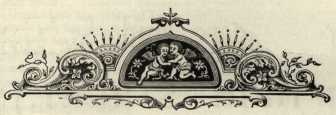
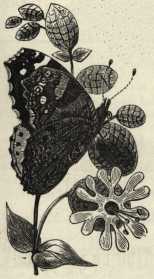 THE
modern history of St. Ives and the development of the town as a
watering place and health resort may he said to have commenced
about a dozen years ago, when the Corporation of the Borough,
with new energy and determination, initiated the works of
public improvement which have since been carried into effect at
a total cost of between £50,000 and £60,000. Seven
years before the town had been connected with the outer world
by the opening of the branch railway, joining the Great Western
main line at St. Erth, but all the hopes excited by this
important event had not yet been fully realized, and owing to
the collapse of the mining industry in the St. Ives district,
and the failure for many years of the pilchard sean fishery,
the trade and business of the town was in anything but a
satisfactory condition. The first work taken in hand by the
Corporation was naturally the much needed improvement of the
harbour. It is not our purpose to relate the history of the
harbour of St. Ives, interesting though the subject undoubtedly
is, but it is sufficient to say that its condition had become
deplorable, and it was felt that something must be done, and
that quickly, to rescue this important fishing and shipping
centre from the ruin which threatened it. The Corporation
commenced their efforts for harbour improvement in 1884, Acts
of Parliament were obtained in 1886 and in 1888, and the last
named year witnessed the laying of the foundation stone of
Smeaton’s Extension Pier by Mr. T. Bedford Bolitho, M.P.,
and two years later, on the 25th June, 1890, the final stone
was laid, amidst general rejoicing, by the Mayor, Mr. Edward
Hain, Junr. To complete the scheme of harbour improvement the
West Pier was afterwards erected, the total cost for new works,
payment of old harbour debts, costs of Acts of Parliament,
&c., being about £35,000. St. Ives now possesses the
best harbour on the north coast of Cornwall, but with growing
requirements and increasing trade another generation may
perhaps witness further additions and improvements.
THE
modern history of St. Ives and the development of the town as a
watering place and health resort may he said to have commenced
about a dozen years ago, when the Corporation of the Borough,
with new energy and determination, initiated the works of
public improvement which have since been carried into effect at
a total cost of between £50,000 and £60,000. Seven
years before the town had been connected with the outer world
by the opening of the branch railway, joining the Great Western
main line at St. Erth, but all the hopes excited by this
important event had not yet been fully realized, and owing to
the collapse of the mining industry in the St. Ives district,
and the failure for many years of the pilchard sean fishery,
the trade and business of the town was in anything but a
satisfactory condition. The first work taken in hand by the
Corporation was naturally the much needed improvement of the
harbour. It is not our purpose to relate the history of the
harbour of St. Ives, interesting though the subject undoubtedly
is, but it is sufficient to say that its condition had become
deplorable, and it was felt that something must be done, and
that quickly, to rescue this important fishing and shipping
centre from the ruin which threatened it. The Corporation
commenced their efforts for harbour improvement in 1884, Acts
of Parliament were obtained in 1886 and in 1888, and the last
named year witnessed the laying of the foundation stone of
Smeaton’s Extension Pier by Mr. T. Bedford Bolitho, M.P.,
and two years later, on the 25th June, 1890, the final stone
was laid, amidst general rejoicing, by the Mayor, Mr. Edward
Hain, Junr. To complete the scheme of harbour improvement the
West Pier was afterwards erected, the total cost for new works,
payment of old harbour debts, costs of Acts of Parliament,
&c., being about £35,000. St. Ives now possesses the
best harbour on the north coast of Cornwall, but with growing
requirements and increasing trade another generation may
perhaps witness further additions and improvements.
The town of St. Ives derives its water supply from various sources, chiefly ancient mine workings, from which the water runs directly into the service mains of the town. The principal supply is known as the Fountain Stream, which never fails, even in the driest season, to afford to the majority of the inhabitants an abundance of pure water more than sufficient for all requirements. The Corporation have recently made a further addition to the supply by the erection of a reservoir on Hellesveor Moors, which is fed by the stream flowing from Wheal Allen Mine, and in summer by pumping from the deep levels of St. Ives Consols Mine. For this purpose one of Merryweather’s powerful steam pumps is used, capable of raising 6000 gallons per hour, so that an abundant supply of pure water is now assured to the inhabitants. Twelve years ago the town was entirely without any system of drainage whatever, but by degrees the higher parts of the town were efficiently drained, and this was followed by the adoption of a comprehensive scheme of sanitary improvement, which has just been completed at a cost of £8000. This, coupled with an improved system of scavenging and removal of house refuse, has had a most beneficial effect in the improved appearance of the town, and in the increased comfort and convenience of the inhabitants. During the autumn of 1894 the purchase of the Gas Works was almost forced upon the Corporation by the failure of the old Gas Company. The works have since been thoroughly reconstructed and made efficient in every way to meet the growing requirements of the town at a cost of £6000. The price to consumers will shortly be reduced, and it is anticipated that both Gas and Water Works will ultimately prove to be most valuable properties for the ratepayers of the town. The number of public lamps has been increased in the past ten year a from about 70 to 150.
No review of recent events in St. Ives would be complete without a passing reference to the Volunteer Fire Brigade. Formed only a few years ago, the Brigade have made themselves thoroughly efficient, and have excited admiration by their promptitude in turning out at the slightest alarm, and by the workmanlike manner in which they have dealt with several rather serious fires. The funds for the purchase of a new engine were raised entirely by the Brigade, and the name St. Ia was given to it by Miss Gracie Hain, daughter of the Mayor, on the 10th August, 1893.
Several events of an exceptional and startling character have occurred in recent years. The blizzard of 1890, the hurricane of November, 1893, which caused such wide-spread disaster round our coasts, and wrecked four steamers in St. Ives Bay, with serious loss of life, nearly forty men being rescued by the Coastguard and their rocket lines from what seemed to be almost certain destruction. But the event which caused the greatest alarm amongst the inhabitants was the flood of November, 1894. For several days rain had fallen in a continuous downpour, and on the morning of the 12th November the accumulated water from the hills around came down with a tremendous rush and poured a perfect torrent into the main streets of the town.
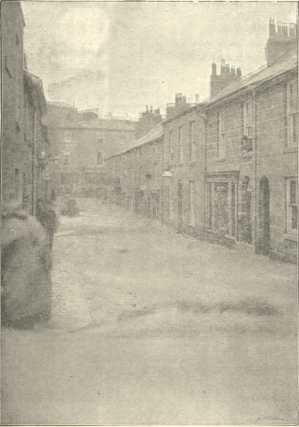
VIEW OF THE FLOODS. — TREGENNA PLACE.
The force of the flood was terrific, huge rocks and stone were carried into the lower streets, houses were washed away, and enormous damage done to property. In many instances the water rushed right through dwellings, knocking out walls and carrying away furniture. Streets and roads were washed up to a depth of many feet, and the gas and water mains broken and destroyed. The torrent, coming down the Terrace main road, quickly filled the Malakoff, and, bursting the walls, the torrent poured into the Railway Yard, rushed past the Station and over the embankment into the sea. But the worst rush of water poured down the Stennack Valley into the main streets of the town. For many hours the people were helpless and nothing could be done. In Chapel Street the waves came leaping down from four to six feet high, and it was not until towards evening — when the torrent had somewhat abated — that the water was partially diverted from the streets and the extent of the disaster ascertained. Fortunately, the flood coming in the daytime, was not accompanied with loss of life, but had it occurred at night the loss of life might have been appalling, as the people, rushing from their houses on the first alarm, must have been swept away by the raging torrent. The loss to the public authority was over £1000, while the loss to owners of property and householders was far greater. It took many weeks before the town resumed its ordinary appearance or the inhabitants recovered their composure. Everything in St. Ives now dates from the flood. We are indebted to Mr. Trevorrow, Photographer, for permission to reproduce the views of the flood, by whom photographs of all descriptions may be obtained. A good selection of views, &c., may be obtained of Mrs. Hodge, Fancy Dealer, stationer, &c., Fore Street.
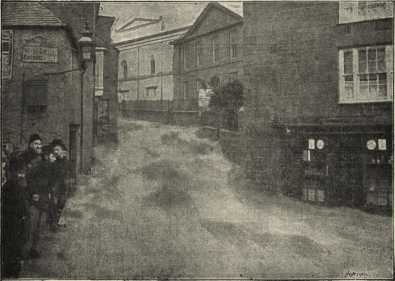
VIEW OF THE FLOODS — STENNACK
St. Ives has been called the “Ilfracombe of the West,” and it undoubtedly has a bright future before it as a watering place and health resort. The number of summer and winter visitors increases yearly, houses being built in all directions. The rateable value of the parish has increased by over £2000 during the past ten years, and the population is steadily increasing. For some time the far famed Tregenna Castle Hotel was the only hotel giving high-class accommodation, but additional provision has been made for visitors by the recent erection of the Porthminster Hotel, near the Station and Beach, overlooking the beautiful Bay of St. Ives. Furnished houses and apartments can also be obtained upon reasonable terms. The large colony of Artists resident in our midst have done very much to make widely known the charms of this district by the exhibition of their pictures on the walls of the Royal Academy and elsewhere. It has been said that St. Ives cannot be exhausted from an artistic point of view. If that is so, we may hope to have the painters with us for many years to come.
Better roads and footpaths and approaches to the cliffs and beaches are being made, more especially by the laying out of Porthminster Hill, recently presented to the town for use as a public park by T. B. Bolitho, Esq., M.P., the expenses incurred in laying out the park being defrayed by the Mayor (E. Hain, Esq., J.P.) The foundation stone of the Passmore Edwards Free Library was laid by the munificent donor in person on the 29th April, which event alone is sufficient to mark the year 1896 in the annals of the borough, but another great event, which is exciting wide spread interest, is the forthcoming visit of the Royal Cornwall Agricultural Society to the town, and for which extensive preparations are being made. In many ways the present year promises to be a memorable one for St. Ives, and the town will, doubtless, take an immense stride in advance, and increase largely in popularity as a resort for tourists and visitors.
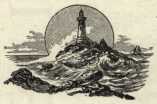
THE Parish Church, which is centrally situated, is an imposing and beautiful edifice eighty feet long and sixty feet wide. The tower is 119 feet high, with battlemented parapet and pinnacles, the latter resting on angles. The church is built on a larger scale than most Cornish churches. It has a naive and two aisles and an additional half-aisle on the south side, commonly known as the “Trenwith Chapel.” On this side there previously existed a chapel in the Roman architectural style, of which a few carved stones, and a beautiful font in the same style, are the only relics preserved in the present church. The font is almost four feet in height, on the bowl of which angels are carved bearing shields and scroll; the altar containing the following inscription in Gothic characters :— “Omnes baptizate genites.” The four lions represented on the base are emblematic of demons cast out by the observance of holy ceremonies. Although the interior and roof of the sacred pile have been extensively restored its numerous historically interesting features have been carefully preserved. The seats in the chancel and the choir stalls bear some curious carvings of saints, crowns, fishes, arabesques, shields and heraldic bearings. On other seats may be found a man’s head encircled with a fool’s cap, bust of a shrew and other grotesque representations. Some of the stories of the wall on the south side are decorated with grotesques, portraying Human and animal faces wearing the most ludicrous expressions. There are several stained-glass windows, two of which are very beautiful. The memorials and standards are worthy of careful investigation, in some cases being weirdly explanatory of certain historical incidents, as will be seen from the following extract culled from the pages of “The Churches of West Cornwall”:— “According to Dr. Oliver the patron saint is St. Ia, an Irish virgin, martyred at Hayle, in Cornwall, about the middle of the fifth century. Other accounts give the dedication to SS. Andrew and Peter. The standards at the east ends of two old seats — that of Master Clies and another — in the chancel, are carved with the figures of SS. Andrew and Peter. These now face the altar. Over St. Peter two figures support a shield, on which are the words ‘John Peyn.’ The standard with the figure of St. Andrew is surmounted by two similar figures with a shield bearing two coats of arms impaled — (l) Three pine-apples; (2) an arrow-head in pale, reversed. The arms of John Peyn, of whom Hals says, alluding to the barbarous execution of insurgents in the reign of Edward VI., ‘In like manner the Marshal hanged John Payne, the Mayor or Portreeve of St. Ives, on a gallows erected in the middle of that town,’ whose arms are still to be seen in one of the foreseats in that church, viz., ‘In a plain field three pine-apples’ The carver had, evidently, never seen pine-apples. The arms are later than the carving of St. Peter beneath.” Our space will only permit a brief reference to this historical building, but there is much in the church and its surroundings which will interest the visitor, who should not fail to inspect the ogival granite cross in the angle of the south porch. One side contains a representation of the Deity exhibiting to the world His crucified Son, whilst figures of the Virgin and Child and other saints adorn the other. The Puritans overturned this curious relic, remaining half-buried until replaced some years ago.
| First Page | Previous Page | Next Page |